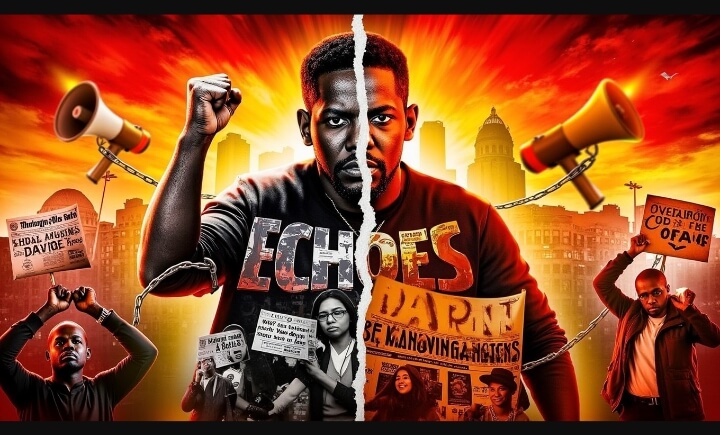A Tense Week in Paramount: Old Fears Resurface
Just last week, the quiet streets of Paramount, California, erupted. Hundreds gathered, their voices loud and signs held high. They were protesting raids by ICE (Immigration and Customs Enforcement). As crowds grew, so did the tension. Some windows broke. Police cars were damaged. For many watching the news, especially folks who remember darker times in Los Angeles, a chilling question popped up: “Is this the start of another LA riot?”
Why “LA Riots” Still Haunt Our City
The words “LA riots” instantly bring back powerful memories for Angelenos. It’s a term tied deeply to two major events in our city’s past:
- The Watts Uprising (1965): Frustration over poverty, unfair policing, and racial discrimination boiled over in the Watts neighborhood. It lasted six days.
- The 1992 Uprising: This is the event most people mean when they say “LA riots.” It exploded after four LAPD officers were found not guilty in the beating of Rodney King, a Black motorist. The anger wasn’t just about that one verdict; it was about years of tension between communities and the police.
The 1992 LA Riots: Five Days That Shook the World
For five terrifying days in April and May 1992, Los Angeles burned. The images shocked the world: buildings on fire, stores being looted, and people fighting in the streets. It was chaos.
- Real People, Real Pain: Remember Reginald Denny? He was just a truck driver delivering sand near Florence and Normandie when the riots started. A mob pulled him from his truck and beat him severely. His rescue, caught on live TV by a news helicopter, became a symbol of the violence and the bravery of strangers who helped him. Korean American shop owners, feeling unprotected by police, famously defended their stores with guns. This became known as the “LA riots Korean” moment, highlighting deep community divisions.
- The Toll: Over 60 people died. Thousands were injured. More than a billion dollars in damage was done. Businesses, many owned by immigrants and people of color, were destroyed. The scars ran deep.
- The Response: Things got so bad that then-Governor Pete Wilson called in the California National Guard. President George H.W. Bush even sent in active-duty soldiers from the Marines at Camp Pendleton and put the Army on alert, using a law called the Insurrection Act. This meant the National Guard and federal troops could help restore order under a kind of martial law situation. National Guard Los Angeles units were crucial in finally calming the streets.
(Learning from the Past: Documentaries Like “LA 92”
Understanding why 1992 happened is crucial. An excellent way to learn is by watching the powerful documentary “LA 92” (released in 2017). It uses raw footage and news reports from the time, showing the events leading up to the riots and the chaos itself. It doesn’t just show the fires; it shows the deep frustration, fear, and broken trust that fueled them. Watching it helps explain what the LA riots signified: a massive cry of pain from communities that felt ignored and mistreated for too long.
Fast Forward: Protests, ICE, and the National Guard Today
The Paramount ICE Protests: What Sparked the Anger?
The recent protests in Paramount, CA, weren’t about a court verdict like in 1992. They were about fear within immigrant communities. Reports of widespread ICE Los Angeles raids targeting undocumented families spread quickly. Groups like the Coalition for Humane Immigrant Rights (CHIRLA) organized peaceful LA protest gatherings. They chanted slogans like “Immigrants are welcome here!” and “Stop the raids!”
- Why People Worry: Many immigrants, even those here legally, fear being separated from their families. They worry about raids happening at homes, workplaces, or even schools. Experts point out that such raids often spread fear far beyond the specific individuals targeted. “It creates a climate of terror,” said one community leader interviewed by the Los Angeles Times.
- When Protests Get Intense: While most protesters in Paramount California were peaceful, a smaller group became destructive. This violence, though limited, triggered immediate comparisons to past riots in LA. The LAPD responded, making some arrests. News helicopters from KTLA News and others circled overhead, broadcasting the scenes live, much like they did in 1992.
The National Guard Question: Could Soldiers Come to LA?
Seeing the images from Paramount, some people asked: “Could the National Guard be sent in here? Could martial law happen?” It’s a serious question, especially with big words like “Trump Insurrection Act” or “Trump deploys National Guard” sometimes mentioned online or on channels like CNN Live.
- Who Can Deploy the National Guard? Normally, the National Guard California is under the command of the state’s governor, Gavin Newsom. He decides if they are needed for state emergencies, like big fires or civil unrest, to support local police. They are citizen-soldiers, often from the communities they serve. You might see “California National Guard” trucks or troops helping during disasters.
- What About the President? Can the President send in troops? Yes, but it’s rare and complicated. The President can use the Insurrection Act to send active-duty military (like the Marines or Army) or take control of the National Guard if a state government can’t or won’t control serious violence that breaks federal law. This is what people mean by “Trump deploys National Guard” – it’s a possible action, but not one taken lightly. Mayor Karen Bass and Governor Newsom would likely strongly oppose such a move in current Los Angeles protests.
- Is Martial Law Happening? Martial law means the military takes over normal government and police functions. This is extremely rare in the US. Sending the National Guard or even federal troops to help police (like in 1992) is not the same as declaring martial law. No one has declared martial law in LA during recent protests.
LA Today: Learning, Healing, and Moving Forward
(H3) Beyond the Headlines: Community Strength
While news reports about “riots in LA today” or “LA protests today” grab attention, the bigger story is often about community. After the Paramount protest, neighbors came together the very next morning. They swept up broken glass, painted over graffiti, and showed support for local businesses. Groups like CHIRLA continue working legally to protect immigrant rights. Leaders like Karen Bass (LA Mayor) and Bill Essayli (a state assemblyman whose district is nearby) have spoken out, calling for calm and solutions.
Why History Matters for Today’s LA News
Understanding the LA Riots 1992 and even the Zoot Suit Riots decades before (which involved racist attacks on Latino youths by sailors and soldiers during WWII) isn’t just about the past. It helps us understand the deep roots of anger and fear that can surface during events like the Los Angeles immigration raids protests or other protests in LA.
- The Core Issues: Poverty, unfair treatment by police or government agencies, fear of deportation, lack of opportunity – these are the kindling. A single spark – an unfair verdict, a violent arrest caught on video, a wave of immigration raids – can ignite it if the underlying problems aren’t addressed.
- The Goal: Most people protesting in Los Angeles, whether in downtown LA or Paramount, want change, not chaos. They want safety, fairness, and respect. They want their voices heard.
(H2) Looking Ahead: Can LA Avoid Another “Never Again”?
After the ashes settled in 1992, Angelenos vowed “Never Again.” Yet, tensions still surface, as we saw in Paramount CA. The question isn’t just can the National Guard be deployed to Los Angeles? It’s how can we address the pain and injustice that makes people feel like protesting, sometimes violently, is their only option?
Building trust between communities and police (LAPD), creating fair immigration policies, and tackling economic inequality – these are the hard, ongoing tasks. Documentaries like “LA 92” remind us of the terrible cost of failure. The cleanup efforts in Paramount show the enduring spirit of community. As we follow LA News Today and California News, remembering our history is the best way to navigate a better future for Los Angeles.
FAQ: Your Questions About LA Protests and Riots Answered
What is the anti-ICE protest about?
These protests, like the recent ones in Paramount and downtown LA, are against raids by ICE (Immigration and Customs Enforcement). Protesters believe these raids are cruel, break up families, and spread fear in immigrant communities, even among people here legally. They want the raids to stop and fairer immigration laws.
What started the riots in Los Angeles (Zoot Suit Riots)?
The Zoot Suit Riots happened in 1943, not during the main “LA Riots” periods. They began when groups of U.S. sailors and soldiers stationed locally attacked young Latino (and some Black and Filipino) men who wore “zoot suits” (a style of baggy suit). It was fueled by racism, wartime tensions, and sensationalized news reports portraying the zoot suit wearers as dangerous gangs. The police often arrested the victims, not the attackers.
What were the Los Angeles riots (1992) and what did they signify?
The LA Riots 1992 were five days of widespread violence, looting, and arson triggered by the not-guilty verdict for four LAPD officers who beat Rodney King. They signified massive anger and frustration in Black and Latino communities over years of police brutality, racial discrimination, poverty, and feeling ignored by the government and society. It was a huge cry for justice and change.
Can the National Guard be deployed?
Yes, in two main ways:
- By the Governor: The governor of California (Gavin Newsom) can call out the California National Guard during state emergencies (like natural disasters or civil unrest) to support local police. This is common.
- By the President: Using the Insurrection Act, the President can send active-duty U.S. military troops or take control of the National Guard if a state can’t control violence that breaks federal laws. This is very rare and serious. Sending the National Guard itself isn’t martial law; martial law means the military replaces civilian government, which is extremely unlikely.



